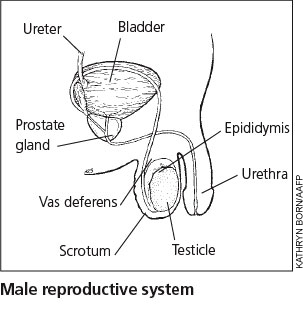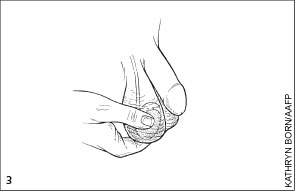
Am Fam Physician. 2004;69(3):613-614
What is cancer?
The body is made up of many kinds of cells. Normally, cells grow, divide, and die. Sometimes, cells change and begin to grow and divide more quickly than normal cells. Rather than dying, these abnormal cells clump together to form tumors. If these tumors are cancerous, they can invade and kill your body's healthy tissues. From these tumors, cancer cells can spread and form new tumors in other parts of the body. By contrast, noncancerous tumors do not spread to other parts of the body.
Testicular cancer begins in one or both of the testicles. The testicles are located in the scrotum, a skin sack that hangs beneath the penis. The testicles make male hormones and sperm. A normal adult testicle is slightly smaller than a golf ball and is round, smooth, and firm.

Who gets testicular cancer?
Cancer of the testicles is the most common cancer in men 20 to 34 years of age. A man is more likely to get testicular cancer if any of the following are true about him:
He is white.
He has a father or brother who has or had testicular cancer.
He has a testicle that did not come down into the scrotum. This applies even if surgery was done to remove the testicle or bring it down.
He has small testicles or testicles that are not shaped normally.
He has Klinefelter's syndrome (a genetic condition).
He already has had cancer in one testicle.
What are some signs of testicular cancer?
A hard, painless lump in the testicle (this is the most common sign)
Pain or a dull ache in the scrotum
A scrotum that feels heavy or swollen
Bigger or tender breasts
Testicular cancer has a good cure rate if it is found early and treated. Your doctor can check your testicles during an exam. A monthly self-exam is another good way to find testicular cancer (see the next page for self-exam directions). If you find anything unusual during a self-exam (like a lump or swelling), see your doctor right away.
How do I do a testicular self-exam?
The best time to do the exam is during or right after a shower or a bath. The warm water relaxes the skin on your scrotum and makes the exam easier to do.
Check your testicles one at a time. Use one or both hands.
Cup your scrotum with one hand to see if there is any change from the way it feels normally (see Picture 1).
Place your index and middle fingers under one testicle with your thumb on top.
Gently roll the testicle between your thumb and fingers.
Feel for any lumps in or on the side of the testicle (see Picture 2). Repeat with the other testicle.
Feel along the epididymis (a soft, tubelike, comma-shaped structure behind the testicle that collects and carries sperm) for swelling (see Picture 3).

It is normal for one testicle to be a little bit bigger than the other. The testicles should be smooth and firm. If you feel any bumps or lumps, visit your doctor right away.